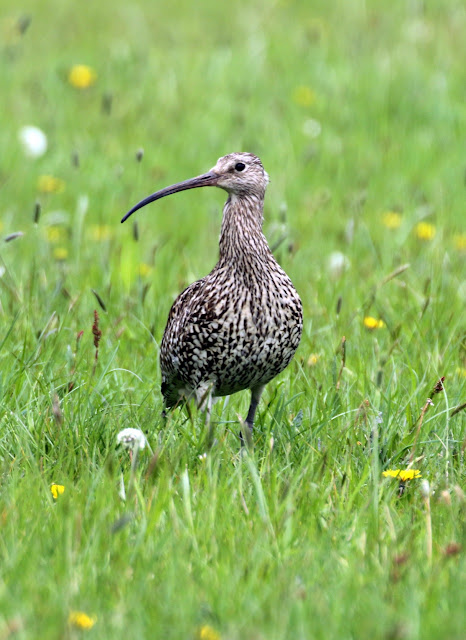 |
Prince Edward Point Lighthouse at dawn,
a scene which greeted me every morning |
With University finished and needing to spread my wings, I decided to volunteer for the autumn (fall) at Prince Edward Point Bird Observatory (PEPtBO) from late September until the end of October. Prince Edward County is located on the north eastern shore of Lake Ontario, about 2hrs east of Toronto - a whole oceans width away from Mid Wales.
 |
Northern Saw-whet Owl, one of 715 caught
in October |
Although a relatively small bird observatory, due to its location right on the tip of a peninsular, it processes a huge number of birds in the fall. The operation is smoothly run by master bander Dave Okines and two fall banding assistants (one of which was me), and a brilliant group of volunteers. The first thing I learnt was some lingo: rings are bands and ringing is banding...luckily with Dave being an expat from Britain, skull ossification was kept to a minimum, with moult and feather wear being used to age birds instead.
The real draw to the station was to witness the fall migration of Northern Saw-whet owls, a small species which breeds in the boreal forest in the north of Canada and migrates as far south as North Carolina in the US. The owl banding was broken down into two separate periods: the standard 4 hour period carried out by myself and the other assistant, then a non-standard period which was carried out until morning by David if the weather and the wind direction was favourable. 10 owl nets were opened each evening around an audio lure which attracted the owls into the area.
 |
Barred Owl, innocent looking but will quite
happily feed on Saw-whets if given the chance. |
It certainly didn't disappoint. In total 715 Saw-whets were banded during October (an astonishing number), with 167 caught in one night alone, 93 of which were during the standard 4 hour period. Each bird was banded and biometrics and a moult card taken for both wings on birds exhibiting any moult before they were released to continue on their migration. Moult was often obvious, although it could be checked using a UV light with new feathers showing up pink from the presence of the chemical porphyrin. This eventually wears off over time, allowing a pattern to be seen between new and old..
 |
| Not quite a nightjar, an Eastern Whip-Poor-Will |
It wasn't just Saw-whet Owls which were caught: 22 Barred Owls, 5 Long-Eared Owls and a single Eastern Screech Owl were caught during my stay. The owl nets also caught a couple
 |
American Woodcock, half the size of the
European Woodcock I'm used to ringing |
of species I was really hoping to see, but wasn't sure I actually would. An Eastern Whip-poor-Will was caught
whilst showing a visiting owl bander from the US the setup one afternoon. It helped demonstrate how quickly the nets could be opened and closed. The second species was an American Woodcock which graced the nets early one morning - a very unusual fall record.
 |
Two tiny male Kinglet species, Golden Crowned Kinglet
& Ruby Crowned Kinglet. |
Migration monitoring also took place in the cedar woods each morning. This used a mixture of 38mm mist nets and larger 100mm hawk nets, along with a Jay Trap and 6 ground traps. These methods caught a wide variety of species during my stay, which ranged from the tiny Golden-crowned Kinglet to the somewhat larger Red-tailed Hawk!
 |
Sparrow lineup: Lincoln's Sparrow, Slate coloured Junco,
Swamp Sparrow, juv White-Crowned Sparrow |
With my very limited knowledge of North American birds it was a steep learning curve, but I soon got used to it and it wasn't long before I could identify and age the wide variety of fall warblers, flycatchers and sparrows which regularly appeared in the nets (they even seem to cause a lot of confusion to American birders). Other more obvious species were also caught such as the Blue Jay, a common and charismatic species that is caught in large numbers throughout the fall with 166 being caught in a single morning during peak migration.
 |
| Blue Beauty, adult male Sharp-Shinned Hawk |
A surprising number of raptors were also caught during my stay, 6 species were caught during the fall. Sharp-Shinned Hawks were the commonest hawk caught, with both females and males banded allowing a range of ages and moult patterns to be seen. 5 Cooper's Hawk were also caught, with all the birds being young birds, a single Merlin, 2 Red-Shouldered Hawks and 4 Red-Tailed Hawks were also caught.
The standout highlight though had to be the juvenile female Northern Goshawk which was caught, a very smart if a little noisy bird to band. It was a brilliant experience, I learnt a lot, saw new ways of setting up nets and heard about some of the more unusual methods of lamping shorebirds and ducks (they use an airboat!). In total I banded and processed 73 species, with a surprising degree of similarity to the species I trained on in Britain. How amazing would it be if one of them ends up in the nets here in Mid-Wales...?
 |
The Northern Goshawk and hairy bander, this is the only real way to show the size of the bird,
an amazingly long tail and this was only a SMALL female... |


















































